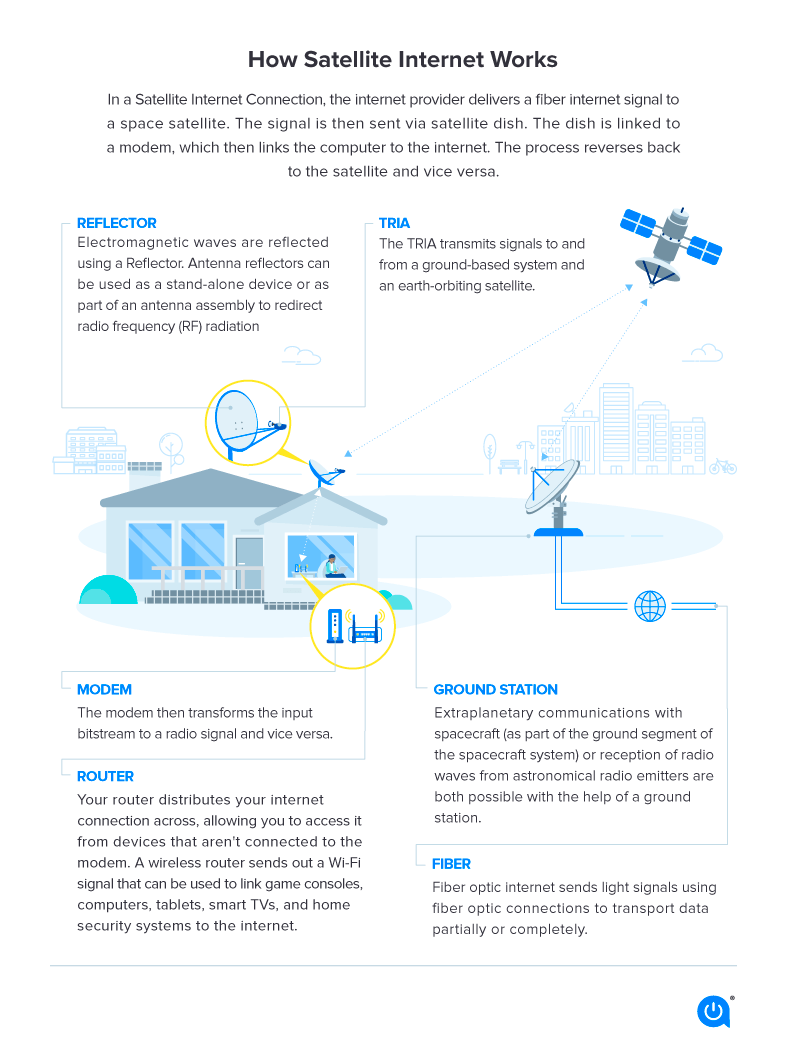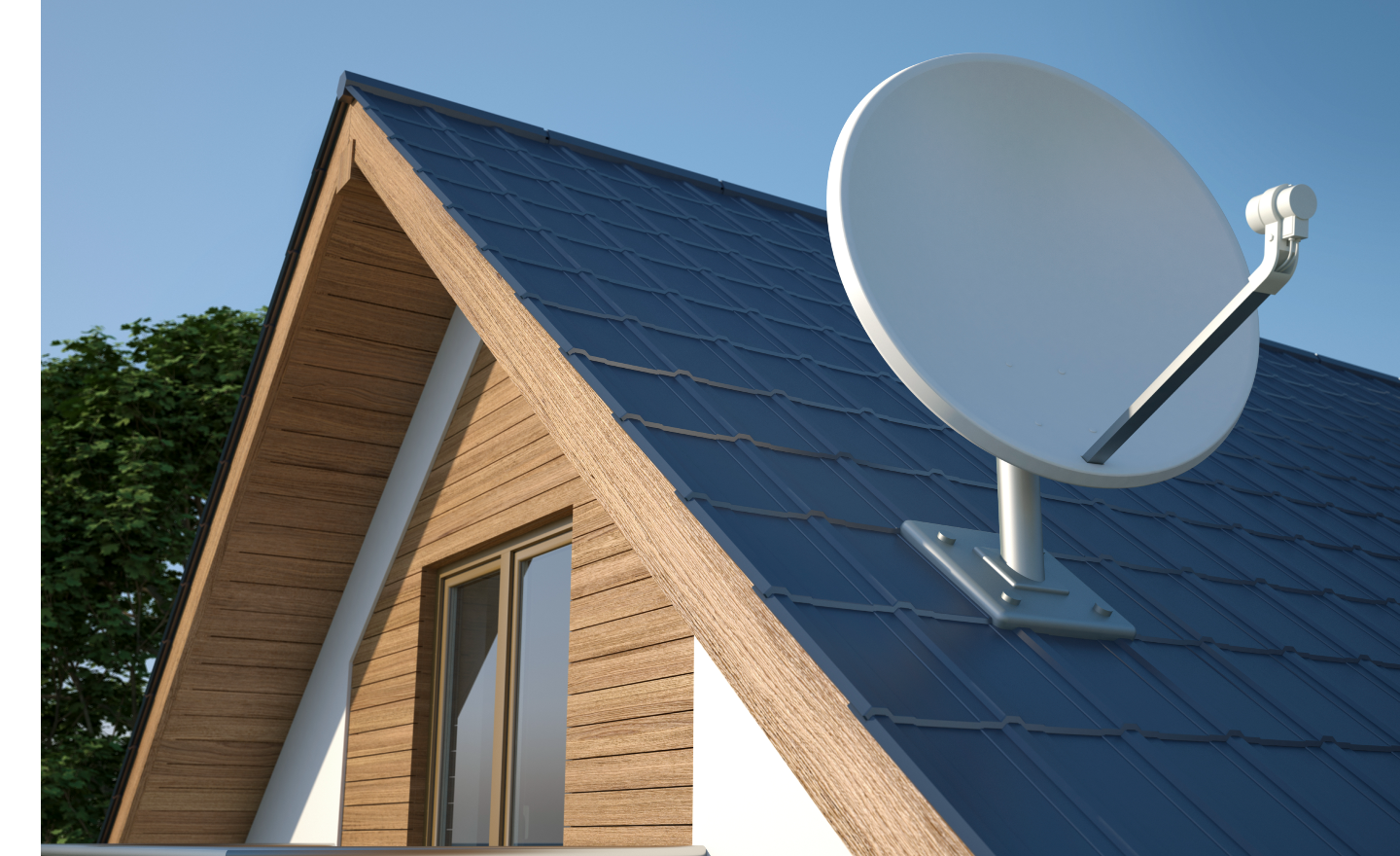Satellite internet is an internet connection that uses satellite signals to send and receive data to the modem in your home. It isn’t as fast as fiber or cable, but it is a solid option for rural internet users and it’s available nearly everywhere.
The main satellite internet providers are HughesNet, Viasat and Starlink, with speeds from 25 to 200 Mbps and prices starting at $49.99/mo.
Satellite internet infrastructure and equipment
Satellite internet requires some hardware to ensure the service reaches your home.
- Satellite dish: Attached to your home with a clear view of the sky.
- Reflector: This dish antenna is used to transmit and receive signals that deliver wireless internet.
- TRIA: The transmit and receive integrated assembly (TRIA) is used on a two-way satellite dish to process signals to and from the provider’s ground station and an Earth-orbiting satellite.
- Fiber internet cables: Cables run underground from the service provider to their ground station.
- Modem: Modems bring internet into your home.
- Router: Routers distribute internet from the modem to your devices.
How satellite internet works
It’s a fairly simple process to receive and set up satellite internet in your home:
- The satellite internet provider sends a fiber internet signal from their ground station to their satellite orbiting the Earth.
- That signal is bounced to the dish on your home.
- Your modem then interprets that signal from your dish to bring internet inside the home.
- Your router then uses it to disperse to your connected devices.
- The signal bounces back and forth between the provider’s ground station, their satellite and your home as you search, stream, game, etc.

The footprint of satellite orbits
HughesNet and Viasat use geostationary (fixed position) satellites that are about 22,000 miles above the Earth’s surface, whereas Starlink uses low-orbit satellites at 340 miles above Earth. Speeds range between 25 to 200 Mbps.
There are three types of orbit, high, medium and low:
- High Earth orbit: Known as geostationary orbit, satellites here move at the speed of the Earth’s rotation. They are 22,000 miles from its surface and are used for telecommunications like internet service from HughesNet and Viasat, as well as for TV signals, which can be broadcast worldwide.
- Medium Earth orbit: According to groundcontrol.com, only 10% of satellites are orbiting at this height – 12,500 miles above the surface. They are used by global positioning systems (GPS) and take less than 24 hours to orbit the planet.
- Low Earth orbit: Satellites here move quickly and take only 90 minutes to orbit the planet at 155 to 1,200 miles above the surface. They are used by internet providers and data collection for scientists, weather reporting and more.
History of satellite internet
First developed in the late 1950s, satellite technology was used for military purposes. The Soviet Union launched the first one in 1957, quickly followed by the U.S. By the 1960s, the tech was being used for commercial communications purposes.
According to HughesNet, “The invention of the World Wide Web created a new role for satellites in communications. In 1993, Hughes Aircraft Company filed for a license with the FCC to develop SPACEWAY, the first Ka-band satellite, which was later launched by Hughes Network Systems, Inc. in 2005. After the success of this launch, the FCC called for more companies to get involved in satellite Internet service, opening up the industry to more companies.”
“At the time, early adopters of internet technology accessed the web using their telephone lines. Instead of waiting for data to crawl through a phone line at mere kilobits per second, users could receive it via satellite at ten times the speed.”
HughesNet anticipates the planned launch of the next generation of ultra-high-density satellites will bring its customers download speeds of 50 to 100 Mbps.
Viasat started offering speeds up to 150 Mbps in some areas and says, “as we add newer, more advanced satellites with global coverage, the service is expected to only get better and faster — as well as available in many more places.”
Starlink offers 100 – 200 Mbps download speeds and is launching more low-orbit satellites monthly.
Weather and satellite internet
Weather can interrupt your satellite signal. HughesNet shares, “A cloudy sky, light rain, or fog shouldn’t impact your internet service. But heavy thunderstorms or heavy snow/ice storms may result in intermittent connectivity or a temporary loss of connection.”
Something to keep in mind is that there may be stormy weather at the ground station where your internet connection starts and that can also interfere with service.
Weather isn’t the only issue that may affect your service. Placement of your dish, high trees and shrubbery and other things may interrupt it.
Allconnect: Let us compare providers for you
Why should you choose Allconnect? We’re the #1 broadband marketplace in the U.S, meaning you can trust us to search, compare and order internet and TV service for your home.
Get started
Written by:
Robin LaytonEditor, Broadband Content
Robin Layton is an editor for the broadband marketplace Allconnect. She built her internet industry expertise writing and editing for four years on the site, as well as on Allconnect’s sister site MYMOVE.com. …
Read more

Edited by:
Camryn Smith-
Featured
![Everything you need to know about Project Kuiper, Amazon’s satellite internet company]() Everything you need to know about Project Kuiper, Amazon’s satellite internet company Ari Howard — 4 min read
Everything you need to know about Project Kuiper, Amazon’s satellite internet company Ari Howard — 4 min read -
Featured
![Does the weather affect your internet?]() Does the weather affect your internet? Robin Layton — 4 min read
Does the weather affect your internet? Robin Layton — 4 min read -
Featured
![Internet connection types: DSL, Cable, Fiber]() Internet connection types: DSL, Cable, Fiber Lisa Iscrupe — 6 min read
Internet connection types: DSL, Cable, Fiber Lisa Iscrupe — 6 min read
Latest
-
Thursday, July 25, 2024
Worried about losing your signal? This is how to keep your satellite dish cleanDavid Anders — 6 min read
-
Tuesday, July 23, 2024
The best free TV and movie streaming services 2024Camryn Smith — 5 min read
-
Tuesday, July 23, 2024
Everything you need to know about internet speedsRobin Layton — 8 min read






